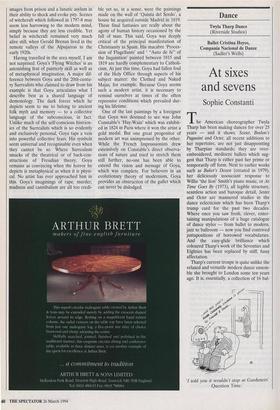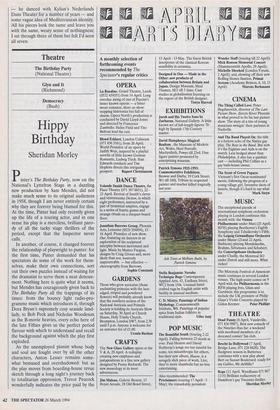Dance
Twyla Tharp Dance (Riverside Studios) Ballet Cristina Hoyos, Compania Nacional de Danze (Sadler's Wells)
At sixes
and sevens
Sophie Constanti
The American choreographer Twyla Tharp has been making dances for over 25 years — and it shows. Sextet, Brahm's Paganini and Octet, all recent additions to her repertoire, are not just disappointing by Tharpian standards; they are over- embroidered, mediocre ballets which sug- gest that Tharp is either past her prime or temporarily off form. Next to earlier works such as Baker's Dozen (created in 1979), her deliciously insouciant response to Willie 'the lion' Smith's piano music, or As Time Goes By (1973), all legible structure, seamless action and baroque detail, Sextet and Octet are mannered studies in the dance eclecticism which has been Tharp's trump card for the past two decades. Where once you saw fresh, clever, enter- taining manipulations of a huge catalogue of dance styles — from ballet to modern, jazz to ballroom — now you find contrived juxtapositions of borrowed vocabularies. And the easy-glide brilliance which coloured Tharp's work of the Seventies and Eighties has been replaced by stiff, fussy affectation.
Tharp's current troupe is quite unlike the relaxed and versatile modern dance ensem- ble she brought to London some ten years ago. It is, essentially, a collection of 16 bal- 'I told you it wouldn't stop at Gardeners' Question Tithe.' let dancers — among them Shawn Black, Keith Roberts and Daniel Chait from American Ballet Theatre, and Shawn Stevens and Stacy Caddell from New York City Ballet. Jamie Bishton is the single remaining member of Tharp's original company and, of the more mature perform- ers, the only one who doesn't appear to be striving for some sad, dopey, all-American ideal of eternal youth. I would guess that Tharp has always made phenomenal demands on her dancers, but her present company seems to bulge with performers who, like their predecessors, obviously rel- ish the challenge of Tharp's choreography yet, simultaneously, are dehumanised by it. Tharp's later work, in particular, offers dance as a series of physical endurance tests. The most undisguised of these sub- liminally sadistic pieces is her In the Upper Room — first at the Coliseum in 1990 — a dance-cum-aerobics marathon for 20 dancers kitted out in Norma Kamali casu- als. As spectacle, it's both admirable and disturbing: an excuse for Tharp to show you how much she knows and how skilfully she blends it all together.
Her tendency to graft technique upon technique is also evident (albeit less suc- cessful) in Sextet, a curiously mealy- mouthed ballet which keeps lapsing into fake Latin sensuality. Three couples engage in busy duets to a score which could be the incidental music from a trashy movie, and while Tharp's sleight of hand is apparent in the seamless partnering, the whole thing seems horribly contrived. In Brahm's Paganini, with its virtuoso solo variations for Jamie Bishton, Tharp's choreography is more substantial and more aligned to dance than to powerhouse ath- letics. But the two men-two women team with whom Bishton shares the stage, pro- vides only symmetric, faceless ornamenta- tion alongside the latter's intemperate gambolling. Unlike Tharp, the Spanish dancer Cristi- na Hoyos specialises in a single dance form —.flamenco — and, although she presents it in a modern context, her interest is in authenticity rather than innovation. In Suenos Flamencos, Hoyos is assisted by seven excellent dancers plus soloist Adrian Galia who, in the fatnica, came close to stealing the show. However, as the self- appointed star, Hoyos gives a marvellous, authoritative performance. Goaded into action by the howls and twangs of her singers and guitarists, she thrashes out a multiplicity of rhythms with her feet, tells another side of the story with her arms and knits her eyebrows together to describe the agony and ecstasy of it all.
Significantly less rivetting was the Corn- pania Nacional de Danza — also at Sadler's Wells and, like Hoyos, part of the current Spanish Arts Festival — which pre- sented two programmes of work by its artistic director and choreographer Nacho Duato. Duato's brand of modern ballet is a competent pastiche of Jiri Kylian's dances — he danced with Kylian's Nederlands Dans Theaterlor a number of years — and some vague idea of Mediterranean identity. All his pieces look the same and leave you with the same, weary sense of nothingness; I sat through three of them but felt I'd seen all seven.




























































 Previous page
Previous page